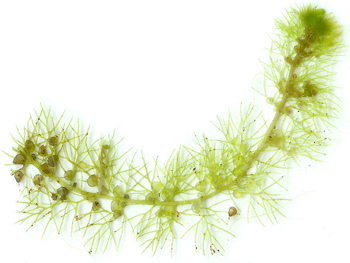Predatory plants 'feed' plants when hungry
Due to scarcity of food, a carnivorous plant swallowed algae to meet their nutritional needs.
Bladderwort, aquatic carnivorous plants or wetlands, have traps like small bubbles on leaves. The pressure inside the trap is lower than the air pressure. Each trap has many extremely sensitive hairs. When a prey approaches and touches a feather, the trap immediately opens. A stream of water carries the animal inside the trunk, where it is digested.
Biologists once saw algae mixed with insects, nematodes and many small animals in the traps of bladderwort, a member of the Utricularia family. So is algae symbiotic of bladderwort or is it accidentally sucked into a trap? Is bladderwort using algae for food?

Bladderwort has traps like bubbles on leaves.Photo: crenvironmental.com.
To clarify questions, scientists from Vienna University (Austria) analyzed 1,450 traps from four species of the Utricularia family. They found that about 80% of the traps had algae. In swamps with higher mineral content, the higher the amount of animals, the less number of algae appears, and vice versa. In places where there are not many animals, bladderwort is forced to eat algae instead. Evidence is that a small amount of algae in the trap is in poor digestibility.
According to Dr. Marianne Peroutka, the lead researcher, some carnivorous plants have "eaten" plants, so we should start calling them omnivores.
- Life of kingfisher family
- Video: Centipede meat gecko on people's houses in Thailand
- The predatory species has the most perfect trap mechanism: Super-long tassel, straight-edged 'mouth' full of acid bait
- 'Immobilized assassin' under the sand
- Close up of hungry harpooning to rejuvenate young antelope
- A discovery can produce proteins to feed millions.
- Admire the moment when the carnivorous plants use 'demon finger' to catch the prey
- Why are people eating so much still hungry?
- Shopping when hungry is not good for health
- Hungry men 'crave' fat women
- 'Assassin tree' glows to lure bait
- Find out why plants can find water
 Why do potatoes have eyes?
Why do potatoes have eyes? 'Tragedy' the world's largest carnivorous life: Death becomes ... public toilet
'Tragedy' the world's largest carnivorous life: Death becomes ... public toilet Tomatoes were once considered 'poisonous' for 200 years
Tomatoes were once considered 'poisonous' for 200 years Detecting microscopic parasites on human face
Detecting microscopic parasites on human face